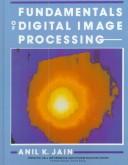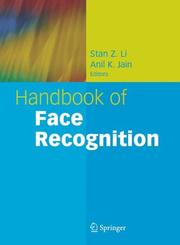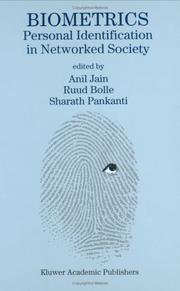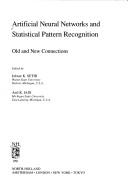| Listing 1 - 10 of 37 | << page >> |
Sort by
|

ISBN: 0133325784 0133361659 9780133361650 Year: 1989 Publisher: London Prentice-Hall
Abstract | Keywords | Export | Availability | Bookmark
 Loading...
Loading...Choose an application
- Reference Manager
- EndNote
- RefWorks (Direct export to RefWorks)
Book
ISBN: 9789332551916 Year: 2015 Publisher: Noida Pearson
Abstract | Keywords | Export | Availability | Bookmark
 Loading...
Loading...Choose an application
- Reference Manager
- EndNote
- RefWorks (Direct export to RefWorks)

ISBN: 1280312335 9786610312337 0387272577 038740595X 1441923454 Year: 2005 Publisher: New York : Springer,
Abstract | Keywords | Export | Availability | Bookmark
 Loading...
Loading...Choose an application
- Reference Manager
- EndNote
- RefWorks (Direct export to RefWorks)
Increased interest in face recognition stems from rising public concern for safety, the need for identity verification in the digital world, and the need for face analysis and modeling techniques in multimedia data management and computer entertainment. This authoritative handbook is the first to provide complete coverage of face recognition, including major established approaches, algorithms, systems, databases, evaluation methods, and applications. After a thorough introductory chapter from the editors, 15 chapters address the sub-areas and major components necessary for designing operational face recognition systems. Each chapter focuses on a specific topic, reviewing background information, reviewing up-to-date techniques, presenting results, and offering challenges and future directions. Features & Benefits: *Provides comprehensive coverage of the main concepts, including face detection, tracking, alignment, feature extraction, and recognition *Presents state-of-the-art methods and algorithms for designing face image-processing and recognition systems *Examines design of secure, accurate, and reliable face recognition systems *Describes performance evaluation methods and major applications, such as security, person verification, Internet communication, and computer entertainment *Integrates numerous supporting graphs, tables, charts, and performance data This accessible, practical reference is an essential resource for scientists and engineers, practitioners, government officials, and students planning to work in image processing, computer vision, biometrics and security, Internet communications, computer graphics, animation, and the computer game industry. Stan Z. Li leads research programs in face detection and recognition, biometrics, and surveillance at Microsoft and is a senior member of the IEEE. Anil K. Jain is university-distinguished professor in the department of computer science and engineering at Michigan State University, as well as a fellow of the ACM, IEEE, and IAPR. Key Topics: Face detection, tracking, and alignment Performance evaluation Subspace analysis methods Illumination and pose modeling Morphable models of faces Facial skin-color modeling Face expression analysis and synthesis Psychological and neural perspectives -- Security / Pattern Recognition -- Intermediate / Advanced.
Human face recognition (Computer science) --- Optical pattern recognition. --- Optical data processing --- Pattern perception --- Perceptrons --- Visual discrimination --- Face recognition, Human (Computer science) --- Facial pattern recognition (Computer science) --- Optical pattern recognition --- Computer vision. --- Artificial intelligence. --- Pattern Recognition. --- Computer Imaging, Vision, Pattern Recognition and Graphics. --- Image Processing and Computer Vision. --- Artificial Intelligence. --- AI (Artificial intelligence) --- Artificial thinking --- Electronic brains --- Intellectronics --- Intelligence, Artificial --- Intelligent machines --- Machine intelligence --- Thinking, Artificial --- Bionics --- Cognitive science --- Digital computer simulation --- Electronic data processing --- Logic machines --- Machine theory --- Self-organizing systems --- Simulation methods --- Fifth generation computers --- Neural computers --- Machine vision --- Vision, Computer --- Artificial intelligence --- Image processing --- Pattern recognition systems --- Pattern recognition. --- Optical data processing. --- Optical computing --- Visual data processing --- Integrated optics --- Photonics --- Computers --- Design perception --- Pattern recognition --- Form perception --- Perception --- Figure-ground perception --- Optical equipment
Book
ISBN: 0387187669 3540187669 3642833276 364283325X Year: 1988 Volume: vol 42 Publisher: New York London Paris Springer
Abstract | Keywords | Export | Availability | Bookmark
 Loading...
Loading...Choose an application
- Reference Manager
- EndNote
- RefWorks (Direct export to RefWorks)
Real-time data processing --- -Robot vision --- -Robotics --- -Automation --- Machine theory --- Robot vision systems --- Vision, Robot --- Computer vision --- Fast-response data processing --- High-speed data processing --- Electronic data processing --- Congresses --- Robot vision --- Robotics --- Congresses. --- -Congresses
Book
ISBN: 9781489974884 1489974873 9781489974877 1489974881 148997489X Year: 2015 Publisher: New York, NY : Springer US : Imprint: Springer,
Abstract | Keywords | Export | Availability | Bookmark
 Loading...
Loading...Choose an application
- Reference Manager
- EndNote
- RefWorks (Direct export to RefWorks)
This encyclopedia provides a comprehensive reference to topics in biometrics including concepts, modalities, algorithms, devices, systems, security, performance testing, applications and standardization. With an A–Z format and over 1400 entries, it provides easy access to relevant information on all aspects of biometrics for those seeking entry into this broad field. Entries are written by experts in biometrics and related fields. Each entry includes a definition, key words, list of synonyms, list of related entries, illustration(s), applications and a bibliography. Most entries include useful literature references providing the reader with a portal to more detailed information. Comprehensive and tutorial, the Encyclopedia of Biometrics, 2nd Edition is a practical resource for experts in the field and professionals interested in aspects of biometrics.
Computer Science. --- Biometrics. --- Signal, Image and Speech Processing. --- Computer Imaging, Vision, Pattern Recognition and Graphics. --- Systems and Data Security. --- Computer science. --- Data protection. --- Computer vision. --- Informatique --- Protection de l'information (Informatique) --- Vision par ordinateur --- Biology - General --- Biology --- Health & Biological Sciences --- Computer security. --- Computer graphics. --- Biometrics (Biology). --- Biological statistics --- Biometrics (Biology) --- Biostatistics --- Biomathematics --- Statistics --- Automatic drafting --- Graphic data processing --- Graphics, Computer --- Computer art --- Graphic arts --- Electronic data processing --- Engineering graphics --- Image processing --- Computer privacy --- Computer system security --- Computer systems --- Computers --- Cyber security --- Cybersecurity --- Electronic digital computers --- Protection of computer systems --- Security of computer systems --- Data protection --- Security systems --- Hacking --- Informatics --- Science --- Statistical methods --- Digital techniques --- Protection --- Security measures --- Machine vision --- Vision, Computer --- Artificial intelligence --- Pattern recognition systems --- Biometric identification. --- Biometric identification --- Biometric person authentication --- Biometrics (Identification) --- Anthropometry --- Identification --- Signal processing. --- Image processing. --- Speech processing systems. --- Optical data processing. --- Optical computing --- Visual data processing --- Bionics --- Integrated optics --- Photonics --- Computational linguistics --- Electronic systems --- Information theory --- Modulation theory --- Oral communication --- Speech --- Telecommunication --- Singing voice synthesizers --- Pictorial data processing --- Picture processing --- Processing, Image --- Imaging systems --- Optical data processing --- Processing, Signal --- Information measurement --- Signal theory (Telecommunication) --- Optical equipment

ISBN: 0387972005 1461279801 1461233607 9780387972008 Year: 1990 Publisher: New York (N.Y.) : Springer,
Abstract | Keywords | Export | Availability | Bookmark
 Loading...
Loading...Choose an application
- Reference Manager
- EndNote
- RefWorks (Direct export to RefWorks)
Book
ISBN: 0387730028 0387730036 0387730044 9780387730028 Year: 2009 Publisher: New York : Springer,
Abstract | Keywords | Export | Availability | Bookmark
 Loading...
Loading...Choose an application
- Reference Manager
- EndNote
- RefWorks (Direct export to RefWorks)
Biometrics refers to automated methods of recognizing a person based on physiological or behavioral characteristics. The Encyclopedia of Biometrics provides a comprehensive reference to topics in Biometrics, including concepts, modalities, algorithms, devices, systems, security, performance testing, applications and standardization. With an A–Z format, the Encyclopedia of Biometrics provides easy access to relevant information on all aspects of biometrics for those seeking entry into this broad field. The Encyclopedia is composed of approximately 250 overview entries, and 800 definitional entries. Each entry includes a definition, key words, list of synonyms, list of related entries, illustration(s), applications, and a bibliography. Most entries include useful literature references providing the reader with a portal to more detailed information. The style of the entries is expository and tutorial, making the encyclopedia a practical resource for experts in the field and professionals in other fields.
Biometry --- Statistics as Topic --- Epidemiologic Measurements --- Epidemiologic Methods --- Public Health --- Investigative Techniques --- Environment and Public Health --- Analytical, Diagnostic and Therapeutic Techniques and Equipment --- Health Care --- Biology - General --- Biology --- Health & Biological Sciences --- Biomathematics --- Molecular biology --- Molecular biochemistry --- Molecular biophysics --- Biological statistics --- Biometrics (Biology) --- Biostatistics --- Statistical methods --- Computer science. --- Computer security. --- Data encryption (Computer science). --- Computer graphics. --- Pattern recognition. --- Biometrics (Biology). --- Computer Science. --- Biometrics. --- Systems and Data Security. --- Computer Imaging, Vision, Pattern Recognition and Graphics. --- Pattern Recognition. --- Data Encryption. --- Mathematics --- Statistics --- Biochemistry --- Biophysics --- Biomolecules --- Systems biology --- Computer vision. --- Optical pattern recognition. --- Cryptology. --- Data encoding (Computer science) --- Encryption of data (Computer science) --- Computer security --- Cryptography --- Optical data processing --- Pattern perception --- Perceptrons --- Visual discrimination --- Machine vision --- Vision, Computer --- Artificial intelligence --- Image processing --- Pattern recognition systems --- Computer privacy --- Computer system security --- Computer systems --- Computers --- Cyber security --- Cybersecurity --- Electronic digital computers --- Protection of computer systems --- Security of computer systems --- Data protection --- Security systems --- Hacking --- Protection --- Security measures --- Optical data processing. --- Design perception --- Pattern recognition --- Form perception --- Perception --- Figure-ground perception --- Optical computing --- Visual data processing --- Bionics --- Electronic data processing --- Integrated optics --- Photonics --- Optical equipment --- Biometrics
Book
ISBN: 085729931X 9786613350800 1283350807 0857299328 Year: 2011 Publisher: New York : Springer,
Abstract | Keywords | Export | Availability | Bookmark
 Loading...
Loading...Choose an application
- Reference Manager
- EndNote
- RefWorks (Direct export to RefWorks)
The history of computer-aided face recognition dates back to the 1960s, yet the problem of automatic face recognition – a task that humans perform routinely and effortlessly in our daily lives – still poses great challenges, especially in unconstrained conditions. This highly anticipated new edition of the Handbook of Face Recognition provides a comprehensive account of face recognition research and technology, spanning the full range of topics needed for designing operational face recognition systems. After a thorough introductory chapter, each of the following 26 chapters focus on a specific topic, reviewing background information, up-to-date techniques, and recent results, as well as offering challenges and future directions. Topics and features: Fully updated, revised and expanded, covering the entire spectrum of concepts, methods, and algorithms for automated face detection and recognition systems Examines the design of accurate, reliable, and secure face recognition systems Provides comprehensive coverage of face detection, tracking, alignment, feature extraction, and recognition technologies, and issues in evaluation, systems, security, and applications Contains numerous step-by-step algorithms Describes a broad range of applications from person verification, surveillance, and security, to entertainment Presents contributions from an international selection of preeminent experts Integrates numerous supporting graphs, tables, charts, and performance data This practical and authoritative reference is the essential resource for researchers, professionals and students involved in image processing, computer vision, biometrics, security, Internet, mobile devices, human-computer interface, E-services, computer graphics and animation, and the computer game industry. Dr. Stan Z. Li is Professor at the National Laboratory of Pattern Recognition, Director of the Center for Biometrics and Security Research, and Director of the R&D Center for Visual Internet of Things, within the Chinese Academy of Sciences. Dr. Anil K. Jain is University Distinguished Professor in the Department of Computer Science and Engineering at Michigan State University, U.S.A.
Human face recognition (Computer science) --- Electrical & Computer Engineering --- Engineering & Applied Sciences --- Electrical Engineering --- Applied Physics --- Computer Science --- Face recognition, Human (Computer science) --- Facial pattern recognition (Computer science) --- Computer science. --- Artificial intelligence. --- Computer graphics. --- Image processing. --- Pattern recognition. --- Computer Science. --- Pattern Recognition. --- Computer Imaging, Vision, Pattern Recognition and Graphics. --- Image Processing and Computer Vision. --- Artificial Intelligence (incl. Robotics). --- Optical pattern recognition --- Optical pattern recognition. --- Computer vision. --- Artificial Intelligence. --- AI (Artificial intelligence) --- Artificial thinking --- Electronic brains --- Intellectronics --- Intelligence, Artificial --- Intelligent machines --- Machine intelligence --- Thinking, Artificial --- Bionics --- Cognitive science --- Digital computer simulation --- Electronic data processing --- Logic machines --- Machine theory --- Self-organizing systems --- Simulation methods --- Fifth generation computers --- Neural computers --- Machine vision --- Vision, Computer --- Artificial intelligence --- Image processing --- Pattern recognition systems --- Optical data processing --- Pattern perception --- Perceptrons --- Visual discrimination --- Optical data processing. --- Optical computing --- Visual data processing --- Integrated optics --- Photonics --- Computers --- Design perception --- Pattern recognition --- Form perception --- Perception --- Figure-ground perception --- Optical equipment

ISBN: 0792383451 9780306470446 9786610205967 1280205962 0306470446 9780792383451 Year: 1999 Volume: SECS 479 Publisher: Boston, Mass. Kluwer Academic
Abstract | Keywords | Export | Availability | Bookmark
 Loading...
Loading...Choose an application
- Reference Manager
- EndNote
- RefWorks (Direct export to RefWorks)
Biometric identification --- Reconnaissance des formes (Informatique) --- Identification biométrique --- Vision par ordinateur --- Automatisation --- -Pattern recognition systems --- Biometric person authentication --- Biometrics (Identification) --- Anthropometry --- Forensic identification --- Machine vision --- Vision, Computer --- Identification biométrique --- Biomathematics. Biometry. Biostatistics --- Artificial intelligence. Robotics. Simulation. Graphics --- Pattern recognition systems --- Identification --- Computer vision --- Automation --- EPUB-LIV-FT SPRINGER-B --- Pattern classification systems --- Pattern recognition computers --- Pattern perception --- Artificial intelligence --- Image processing --- Identification - Automation

ISBN: 0444887407 9780444887405 9781483297873 148329787X 132247236X 0444887415 9780444887412 Year: 1991 Publisher: Amsterdam, Netherlands ; New York, New York : North-Holland,
Abstract | Keywords | Export | Availability | Bookmark
 Loading...
Loading...Choose an application
- Reference Manager
- EndNote
- RefWorks (Direct export to RefWorks)
With the growing complexity of pattern recognition related problems being solved using Artificial Neural Networks, many ANN researchers are grappling with design issues such as the size of the network, the number of training patterns, and performance assessment and bounds. These researchers are continually rediscovering that many learning procedures lack the scaling property; the procedures simply fail, or yield unsatisfactory results when applied to problems of bigger size. Phenomena like these are very familiar to researchers in statistical pattern recognition (SPR), where the curse of dimen
Pattern recognition systems. --- Neural networks (Computer science) --- Artificial neural networks --- Nets, Neural (Computer science) --- Networks, Neural (Computer science) --- Neural nets (Computer science) --- Artificial intelligence --- Natural computation --- Soft computing --- Pattern classification systems --- Pattern recognition computers --- Pattern perception --- Computer vision --- Pattern recognition systems
| Listing 1 - 10 of 37 | << page >> |
Sort by
|

 Search
Search Feedback
Feedback About UniCat
About UniCat  Help
Help News
News